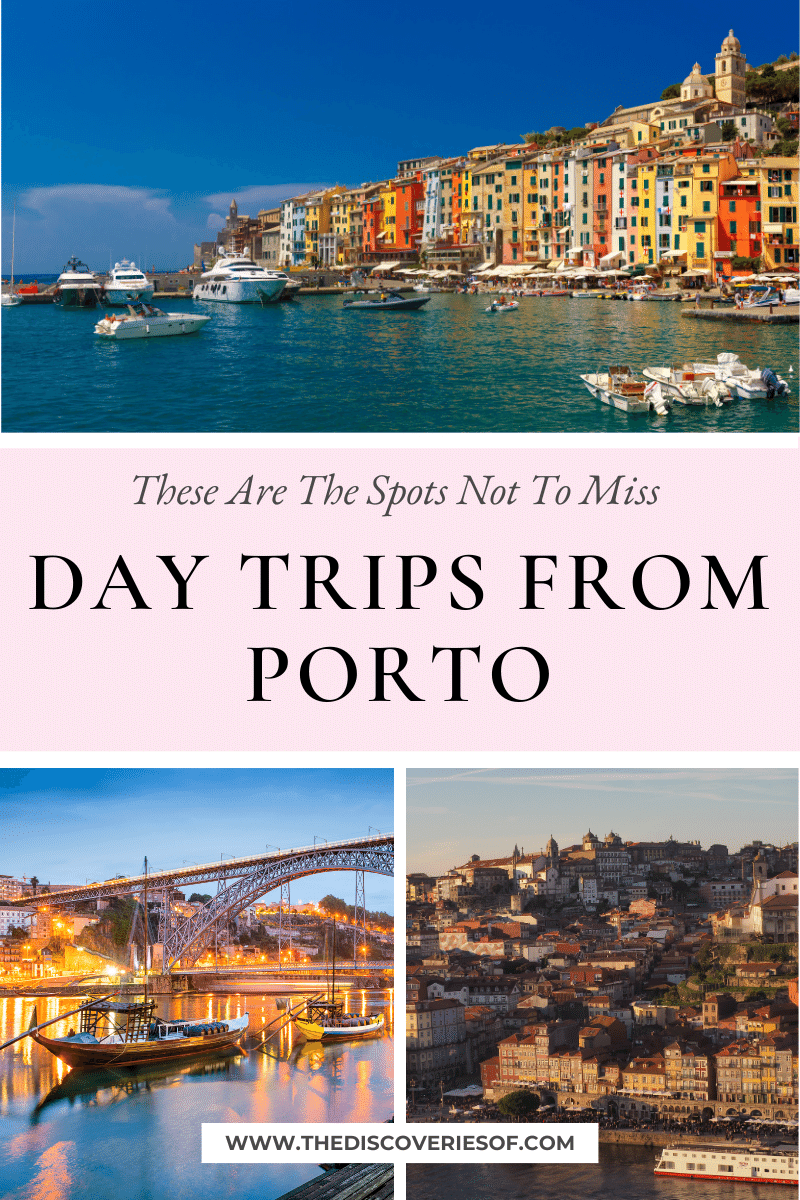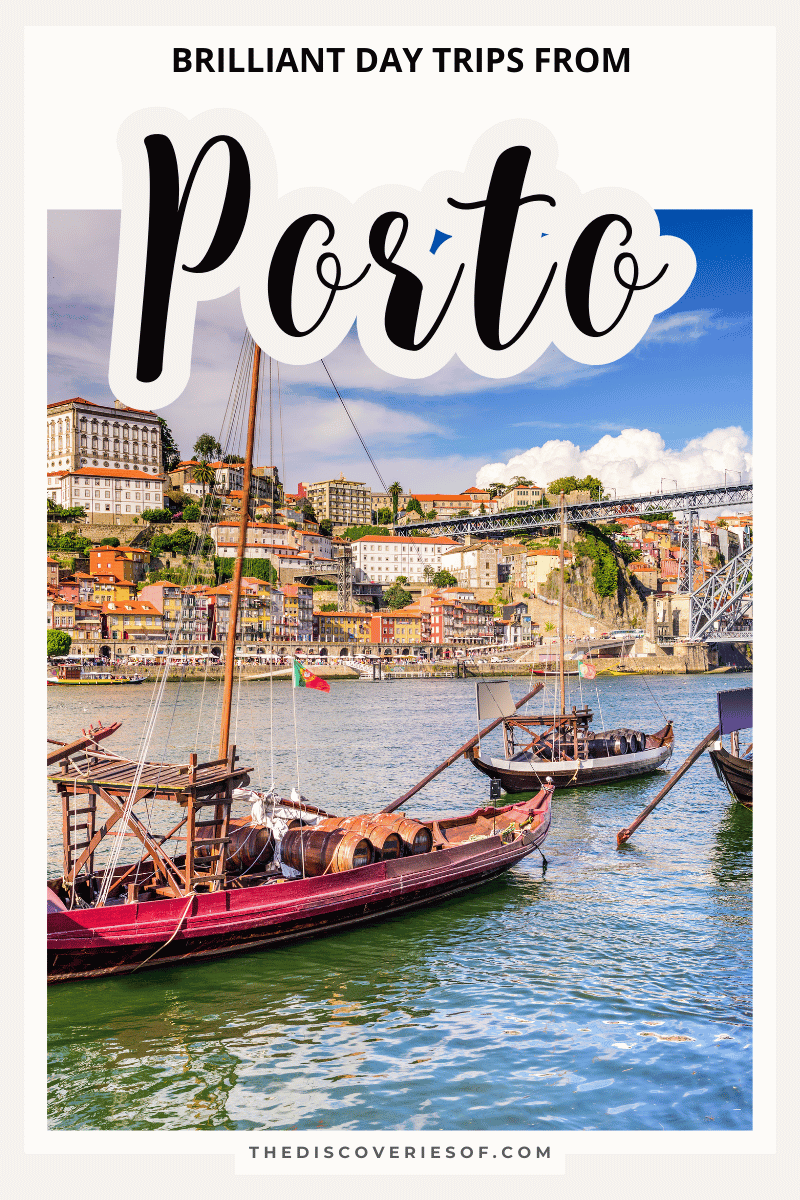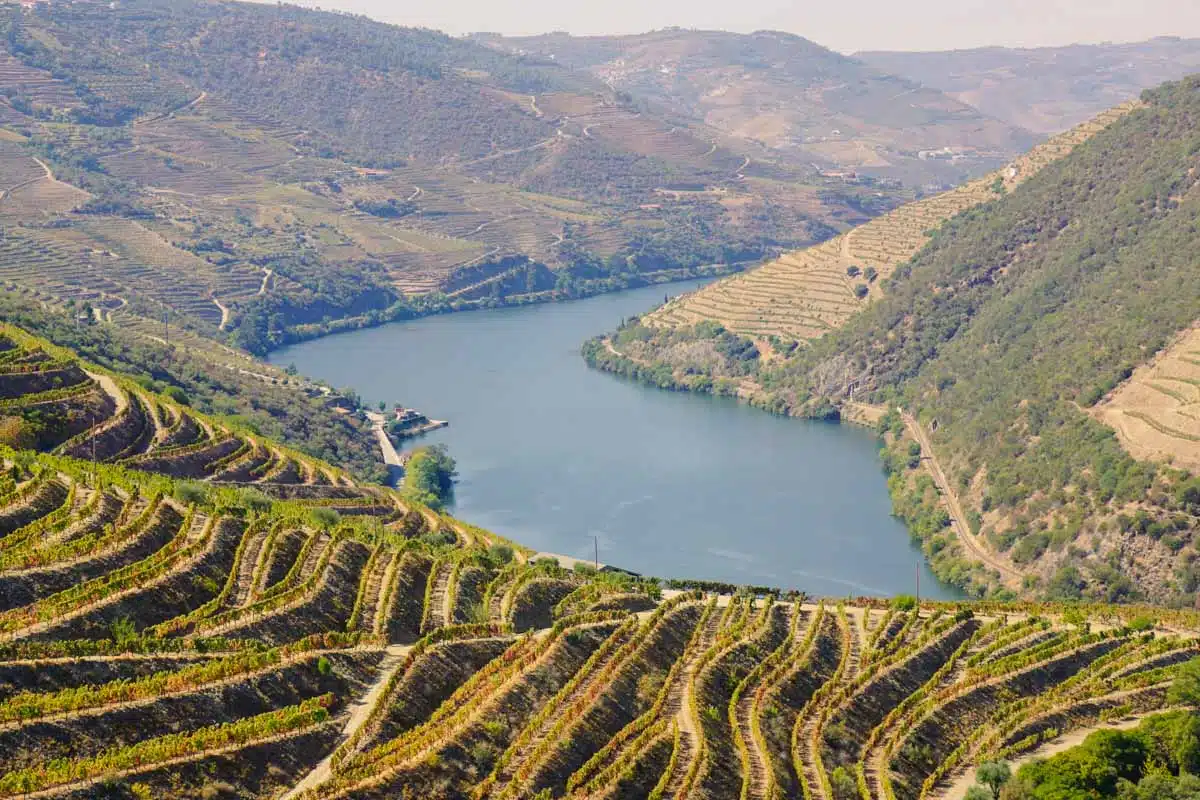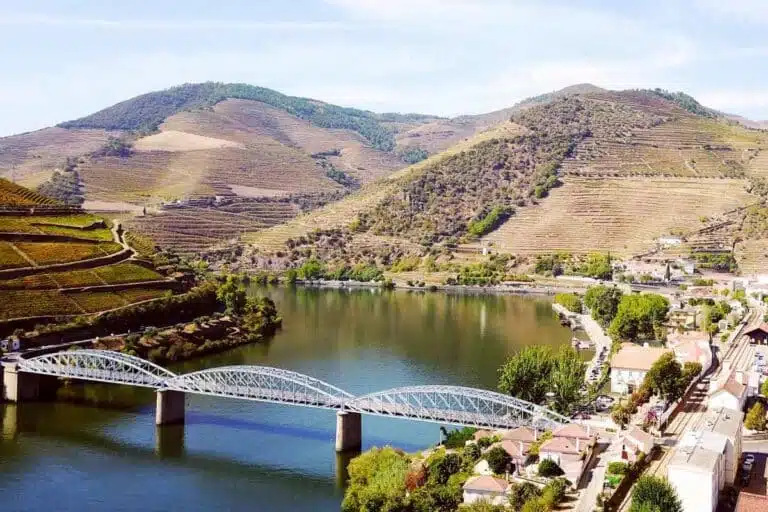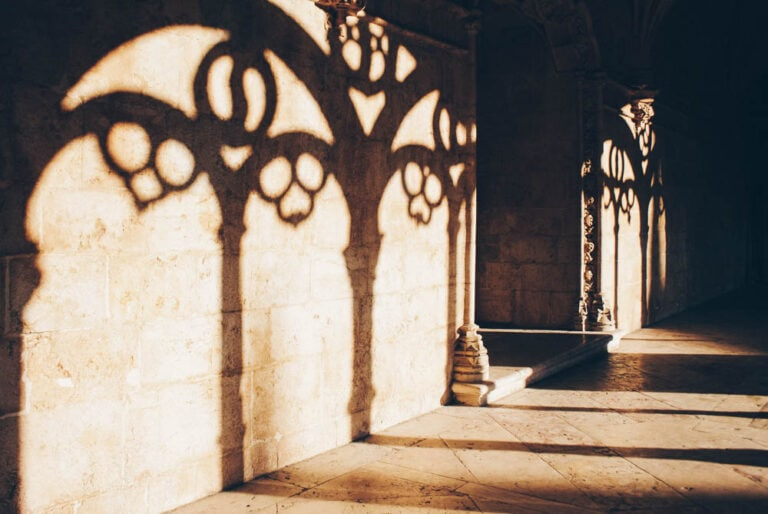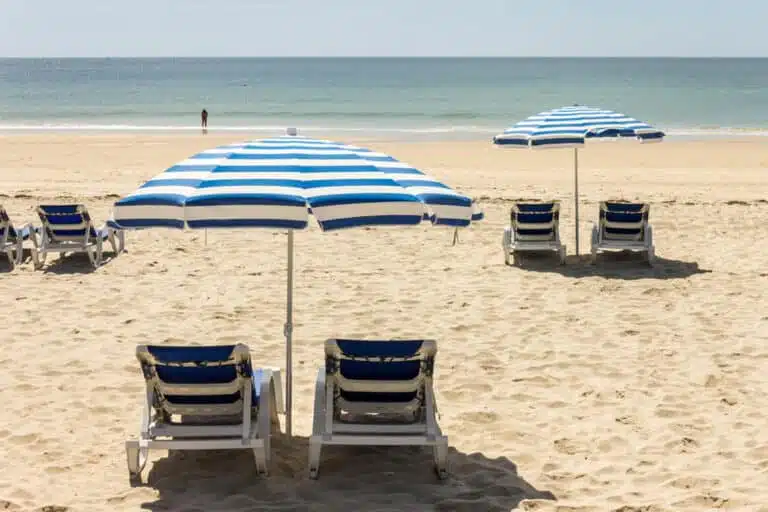Porto is the perfect base for exploring Portugal. From the gorgeous rolling hills of the Douro Valley to the architectural marvels of Sintra, these are the best day trips from Porto.
It’s no secret that I love Porto. The sheer spectacle of the Ribeira – with its staggered terracotta roofs meandering down to the Douro River is reason enough to make you look twice – but add to that a strong culinary scene, cultural heritage and some straight-up stunning historical attractions and – well, it’s love.
It just so happens that Porto is also the perfect jumping off point for exploring some of Portugal’s coolest spots.
Let’s discover the best day trips from Porto: beaches, dramatic architecture and unique curiosities await.
The Best Day Trips From Porto
Douro Valley
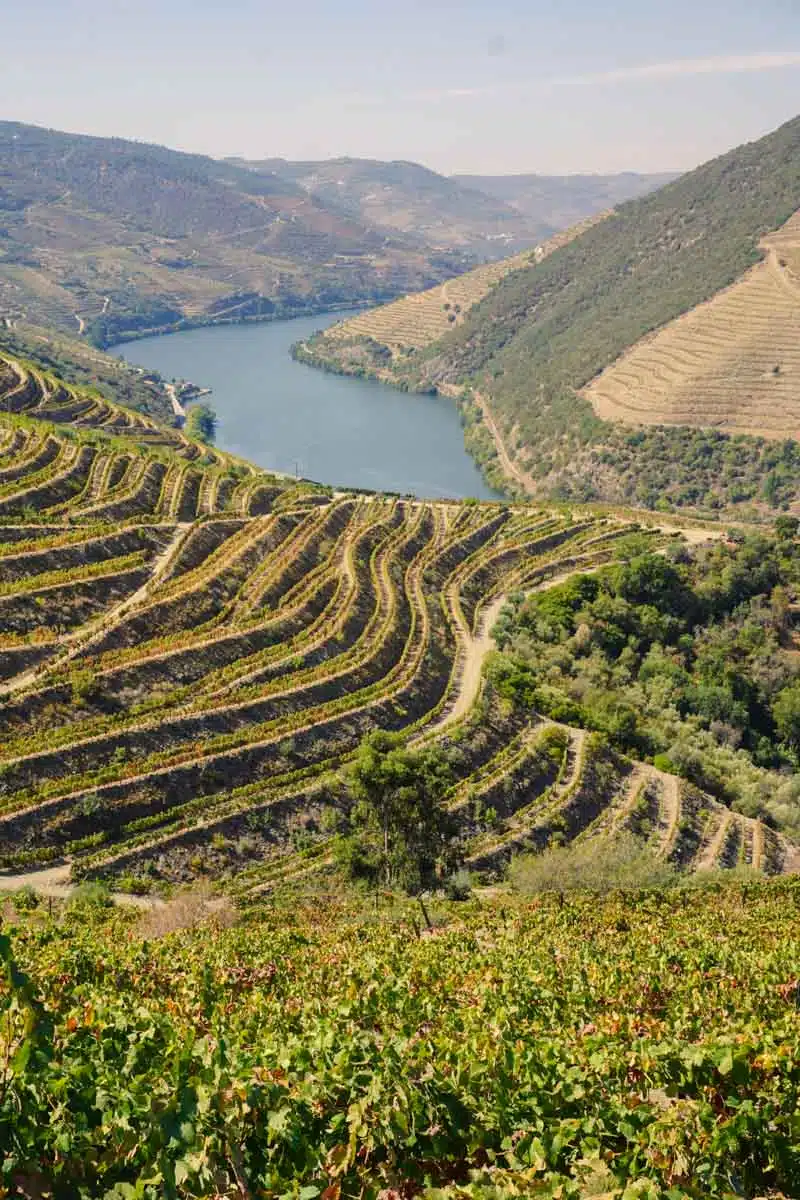
Few places beat the Douro Valley for gorgeous scenery. Picture terraces of vineyards clustered on verdant slopes, punctuated by the meandering path of the Douro River.
A trip to this UNESCO-protected wine region in Portugal is one of the ultimate Porto day trips. You can see where they make port wine and spend your time touring the vineyards and *more importantly* tasting the port and wine they produce.
If that all sounds too sedate, kayak down the Douro River valley or hop on a cruise and watch the tiny scenic towns go by. You can easily find a Douro Valley tour from Porto if you prefer your day organised for you.
How to Get There: You can go by train from Campanha Station. The end of the line is Pocinho Station, but you can get off at Peso da Régua.
Average journey duration: 1 hour 50 minutes to 3 hours 17 minutes.
Hassle-free option: Book this boat tour with a wine tasting and lunch.
Braga
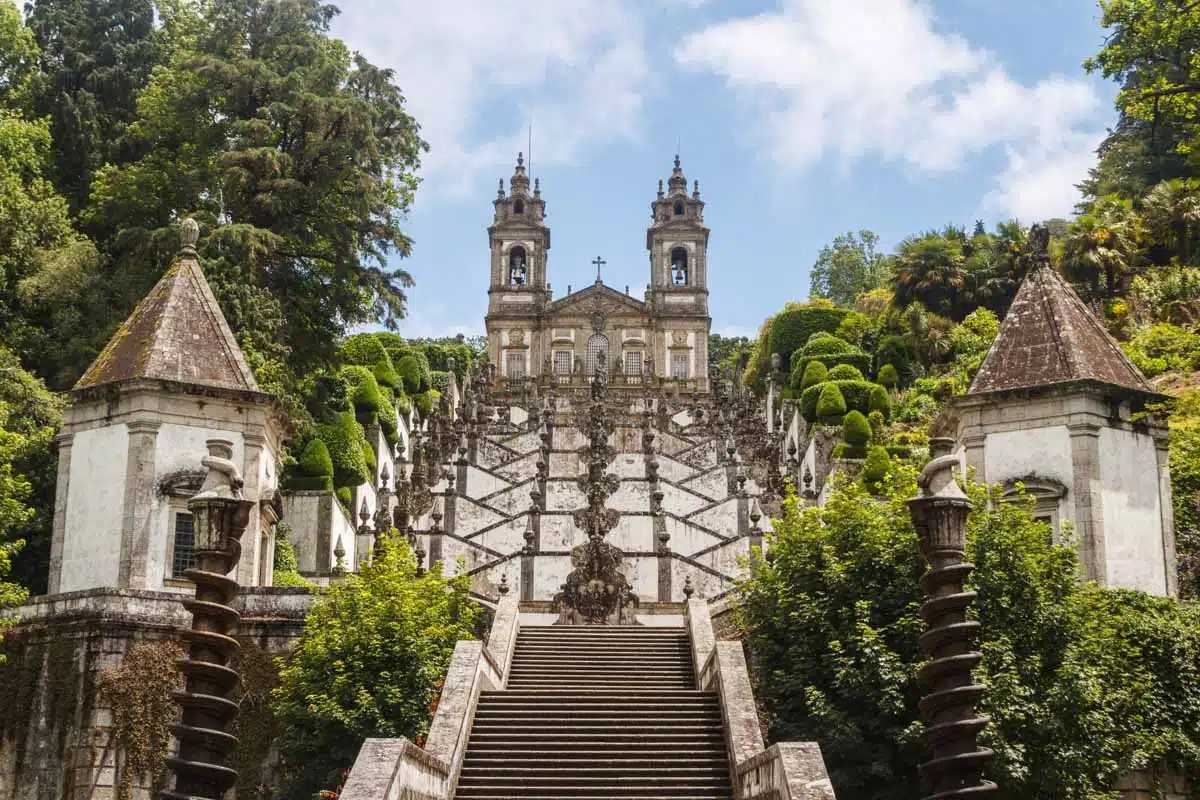
Cute cafés and traditional dishes in a charming Portuguese town by the water — what’s not to love? Spend your time being gastronomically blown away by fusion foodie creations and northern Portuguese cuisine.
After you’re fully fueled up, walk off those calories by visiting the many churches and cathedrals like the Braga Cathedral, which is older than the country itself.
During a Braga day trip from Porto, you can’t walk for 10 minutes straight without tripping over a church or two, so make the most of it and enjoy the unique architecture.
How to Get There: Take a train from Campanha Station to Braga Station.
Average journey duration: 1 hour 7 minutes.
Hassle-free option: Book a full-day tour with lunch.
Aveiro
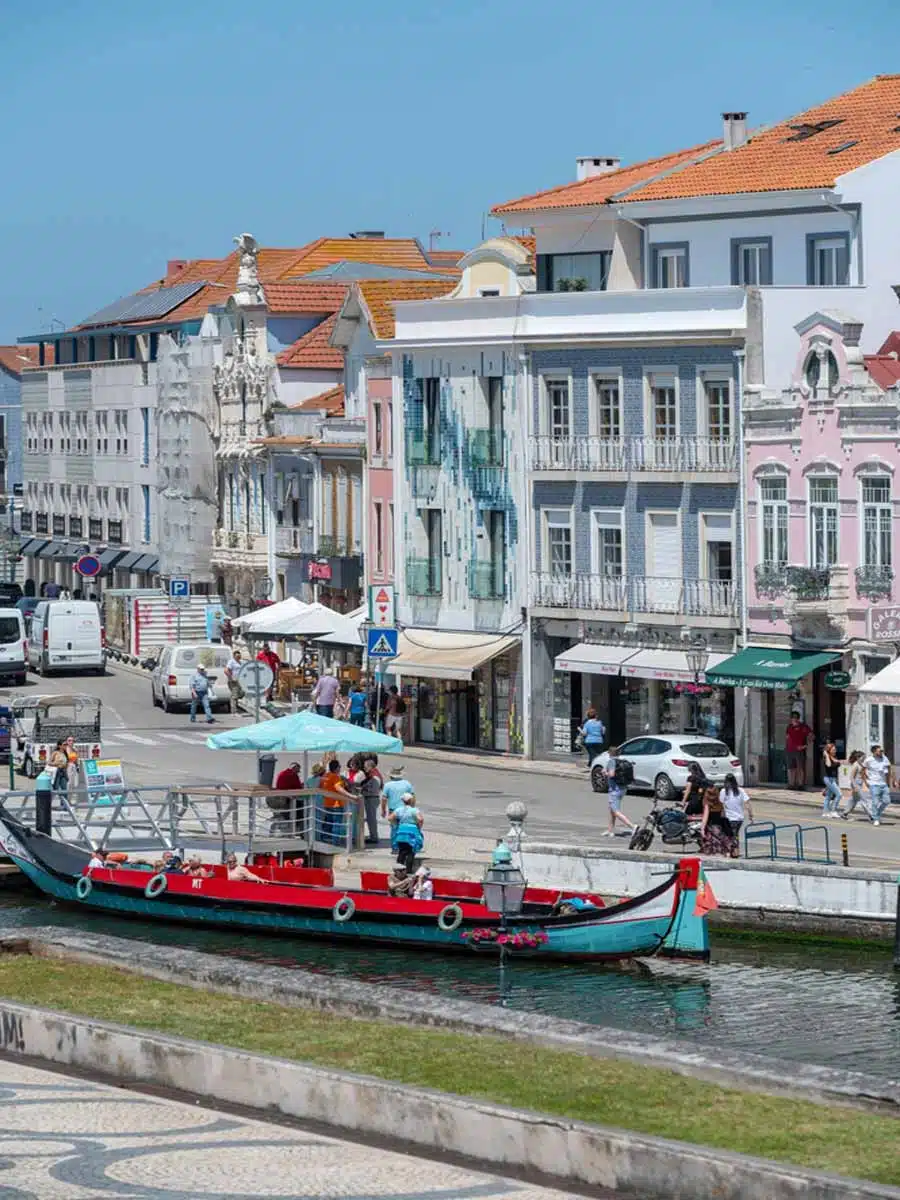
It might seem like your average quaint fishing village, but Aveiro has the feel of a tiny Venice with canals, colourful boats, and old houses.
There are monastery buildings showcasing gorgeous sculptures and religious art, moliceiro boat tours to take, and an old train station from 1916 bedecked in blue and white tiles.
Though it may seem pretty low-key initially, a day trip from Porto to Aveiro is one of the best ways to spend your time in Portugal.
How to Get There: A train runs from Campanha Station to Aveiro Station.
Average journey duration: 1 hour and 10 minutes.
Hassle-free option: Book this half-day tour with a cruise.
Nazaré
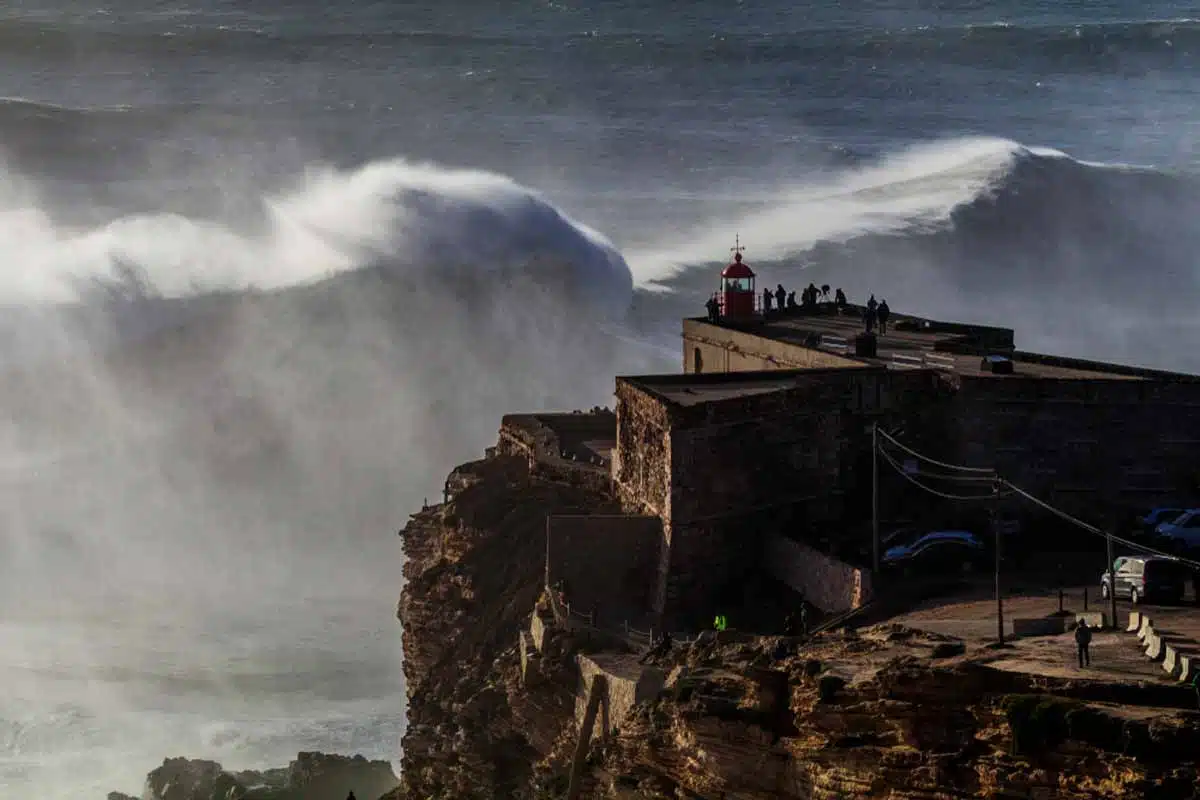
It’s one of Portugal’s top surf spots featuring big wave surf, all thanks to Europe’s largest underwater canyon that pushes the water up sky-high.
If you’re a beginner, it’s better to sit back and relax on the beach, or venture into the laidback fishing village with charming old buildings facing the sea.
But experienced pro-surfers are in for the ride of their lives at Praia do Norte or Praia do Nazaré, especially from April to October. The waves are milder in the summer, so intermediates can handle them.
How to Get There: Take a bus from Porto Campanha Bus Station.
Average journey duration: 2 hours and 50 minutes.
Lisbon
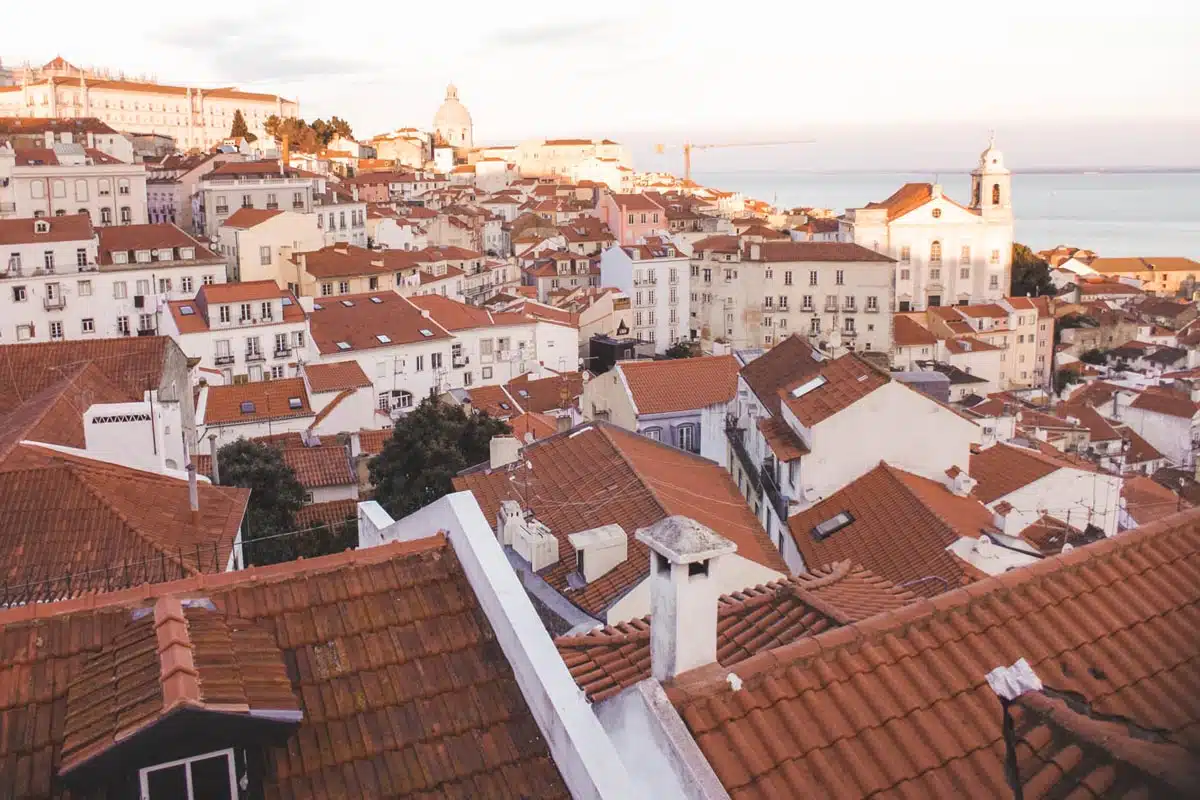
I can’t make a list like this and not include Lisbon.
There are plenty of big-name attractions that might make your list on a day trip from Porto to Lisbon, but sometimes steering away from the tourists is more appealing. Hang out in the city centre and ride the Santa Justa lift to the Carmo Convent, or sip on cherry liqueur from a cool Lisbon rooftop bar before heading to the São Pedro de Alcântara viewpoint.
Or visit the São Jorge Castle and wind along the backstreets of Alfama. There are so many incredible things to do in Lisbon, it can be hard to narrow it down.
How to Get There: You can take the train from Campanha Station to Santa Apolonia Station.
Average journey duration: 3 hours.
Hassle-free option: Book this private transfer to Lisbon.
Arouca
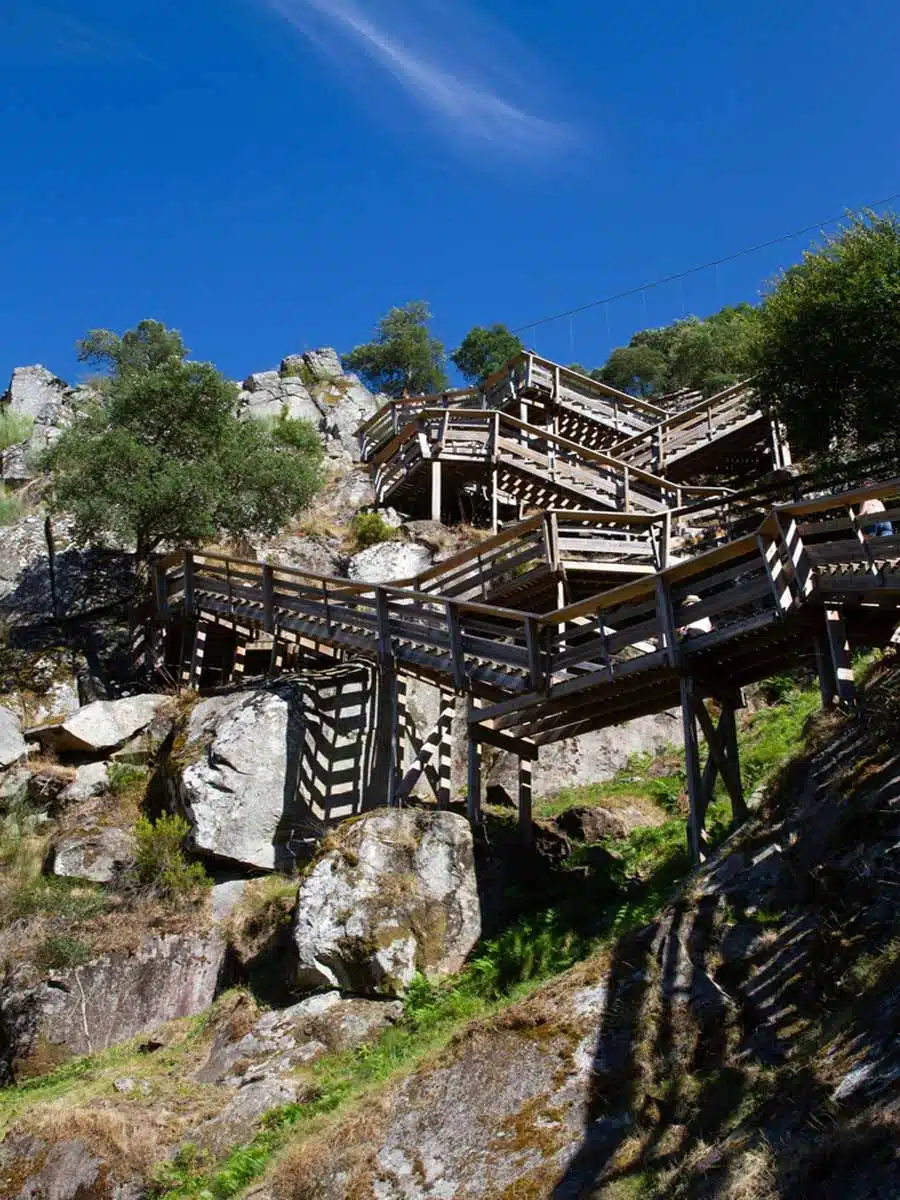
Arouca has some of the most interesting and unique attractions, not limited to its beautiful churches and trilobites museum.
I’m talking about the Paiva Walkways: 5.5 miles of teetering wooden stairs and walks along the steep bank of the Paiva River. If your calves aren’t up to the challenge, fight your fear of heights and tackle the 516 Arouca Bridge.
It’s almost 1,700 feet long suspended 570 feet in the air, crossing from one side of the Paiva to the other. It’s the largest pedestrian suspension bridge in the world, making Arouca one of the best day trips from Porto.
How to Get There: Take the Line 9 bus to Rio Mau, then hop on a taxi the rest of the way.
Average journey duration: 1 hour and 27 minutes.
Hassle-free option: Book this Aveiro, Paiva Walkways, and 516 Arouca Bridge tour.
Lamego
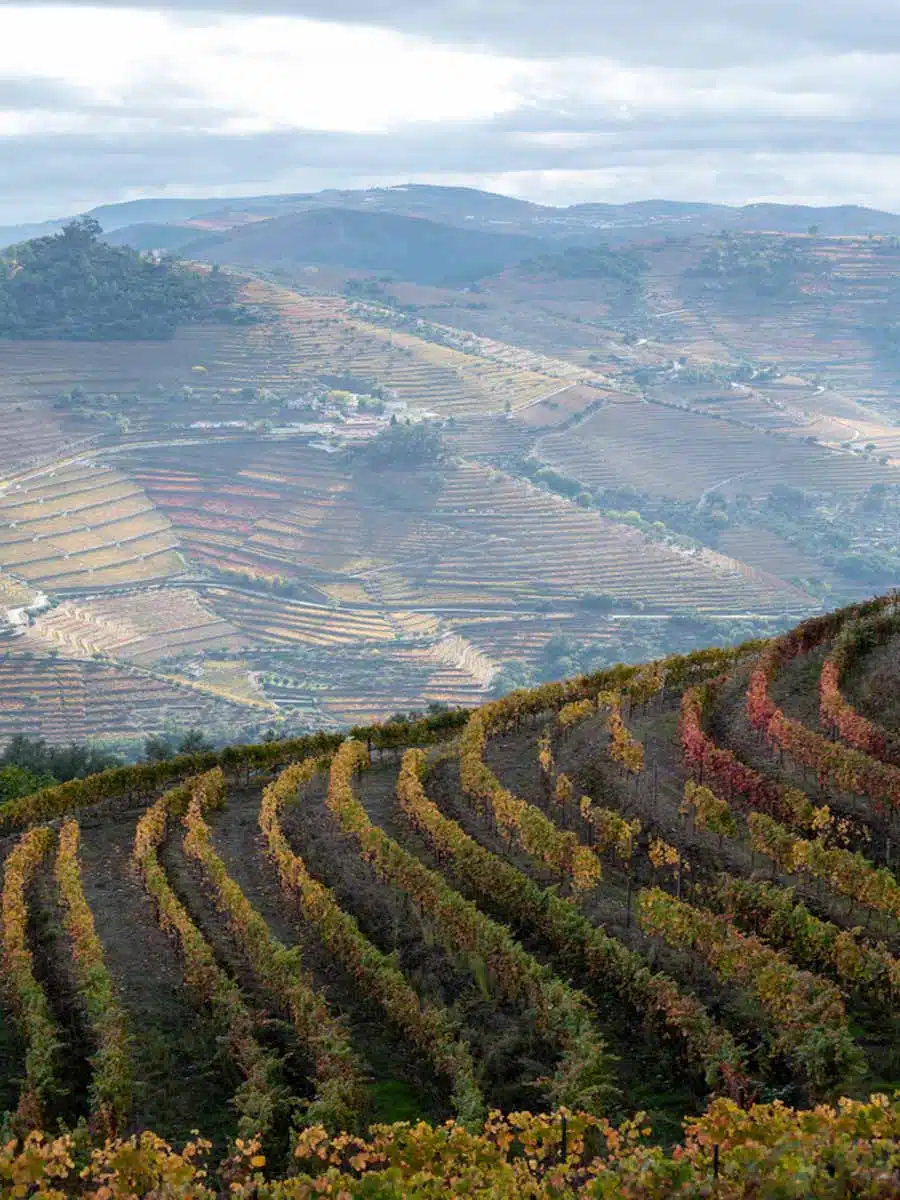
When indulging in a day trip from Porto to Douro Valley, you can’t miss the town of Lamego. It has the most glorious white chapel with intricate architecture and a flight of stairs covered with extensively decorated blue and white tiles.
It’s called the Santuário de Nossa Senhora dos Remédios, and it’s truly breathtaking.
There’s also the Lamego Cathedral and Lamego Museum to visit, the latter of which is inside a golden repurposed chapel.
How to Get There: The Citi Express bus goes to Lamego six times a week.
Average journey duration: 2 hours and 10 minutes.
Santiago de Compostela
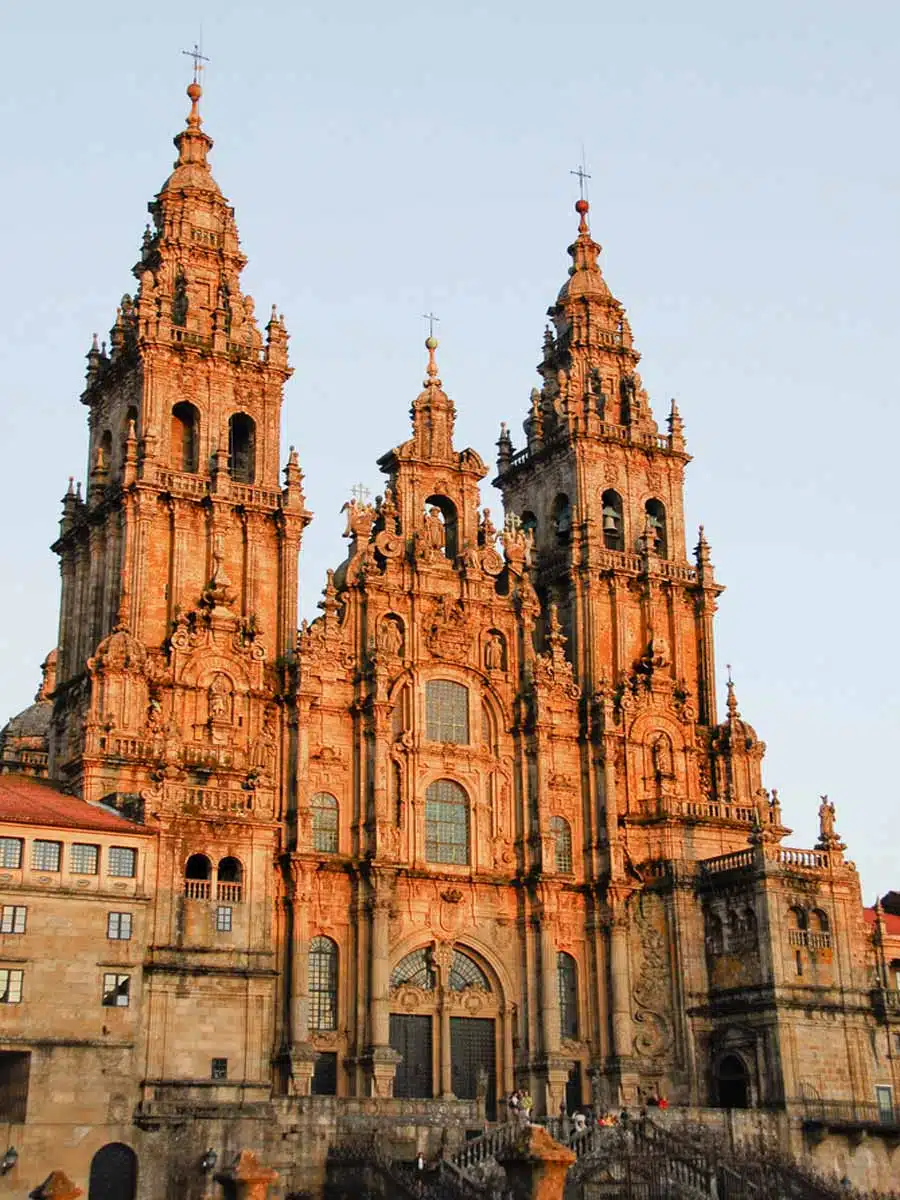
You’ll need to leave early for a day trip from Porto to Santiago de Compostela in Spain. It’s known as the final destination on the Camino de Santiago pilgrimage, and as such it’s full to the brim with religious heritage sites.
The main one is the Cathedral of Santiago de Compostela, where people believe St. James, the biblical apostle, lies buried. The architecture is Romanesque, which you’ll see abundantly in Zona Vella. Stop by Mercado de Abastos for your foodie fix before you leave.
How to Get There: You can take a direct bus from Campanha to Santiago de Compostela.
Average journey duration: 4 hours and 20 mins.
Vila Real
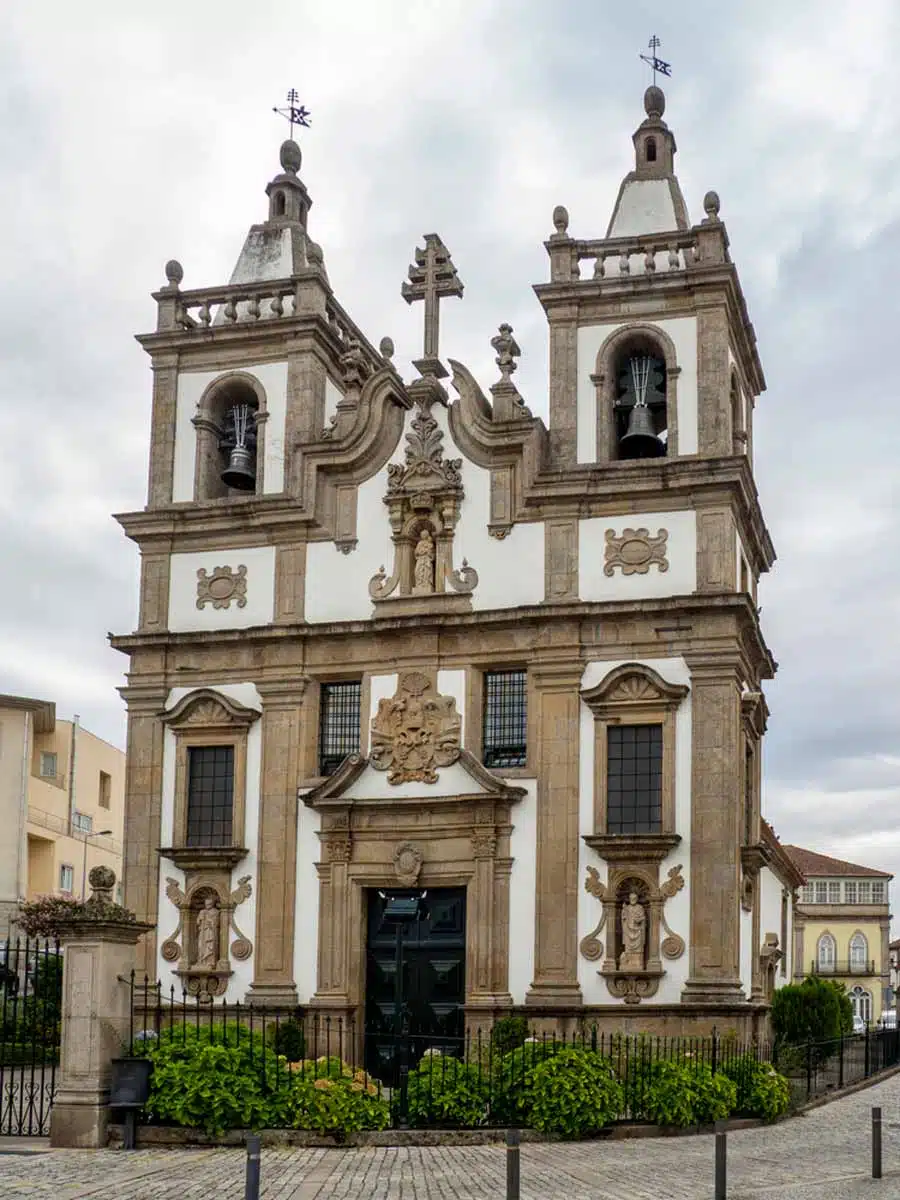
It’s the largest town in the Tras-o-Montes province and has many interesting places to see, like the Casa de Mateus (you’ll see it featured on Mateus rosé wine bottles).
It was designed by the same Italian architect who designed half of Porto, so don’t feel surprised if you feel a sense of familiarity.
The Portuguese royals would use it as a summer home, so you know luxury is the name of the game here. You can also check out the UTAD Botanical Garden and the Capela Nova (New Chapel).
How to Get There: You can take the Rodonorte bus, which runs to Vila Real hourly.
Average journey duration: 1 hour.
Hassle-free option: Book this Porto and Gaia city tour in a replica Model T Ford.
Sintra
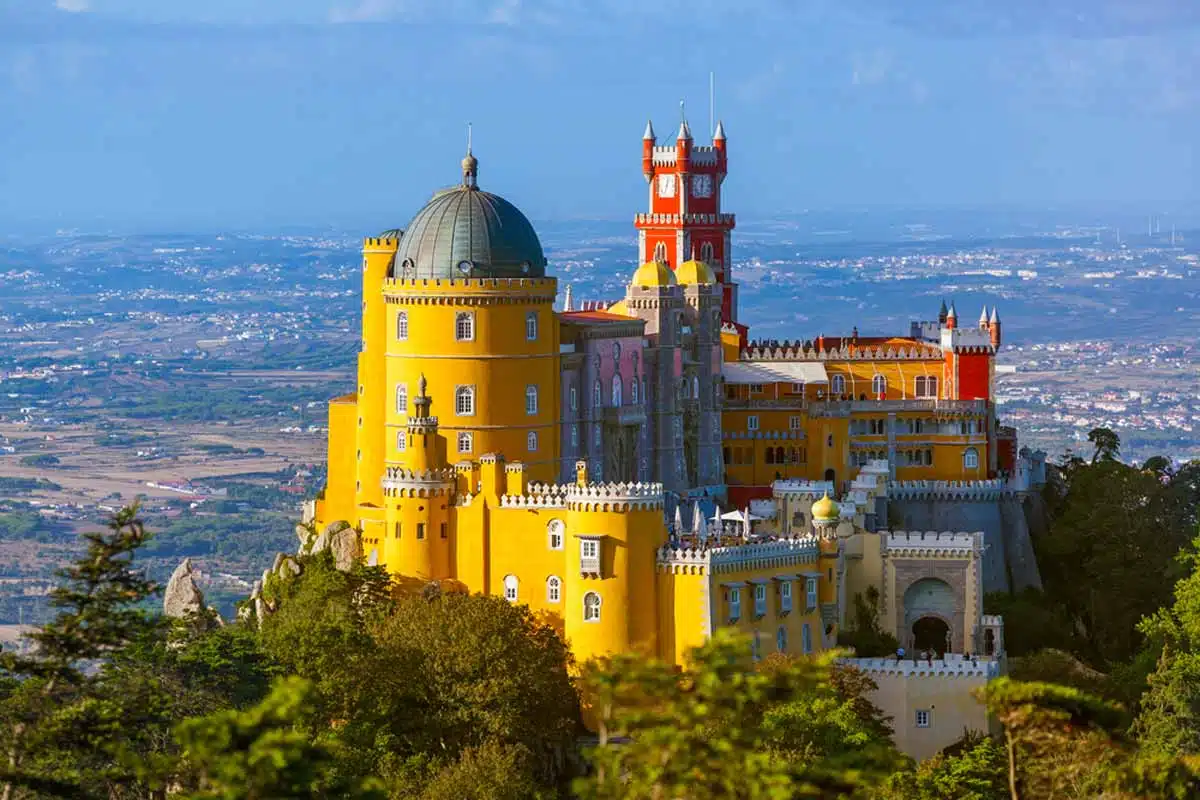
The Quinta da Regaleira Castle is slightly eerie but somehow gorgeous simultaneously, but Pena Palace steals the show when it comes to Sintra.
It’s a multicoloured wonder of Portugal built on top of an old monastery and has a distinct Disney vibe.
There’s also the Castle of the Moors to visit (there are many stairs, so get ready for a workout) and the Park and Palace of Monserrate with a similar fantastical feel. The first thing you should do though, is a walking tour of the old centre with its cobbled streets, mansions, townhouses, and churches, before it becomes inundated with tourists.
How to Get There: You can take the train from Vila Nova De Gaia-Devesas station to Sintra.
Average journey duration: 3 hours and 43 minutes.
Guimarães
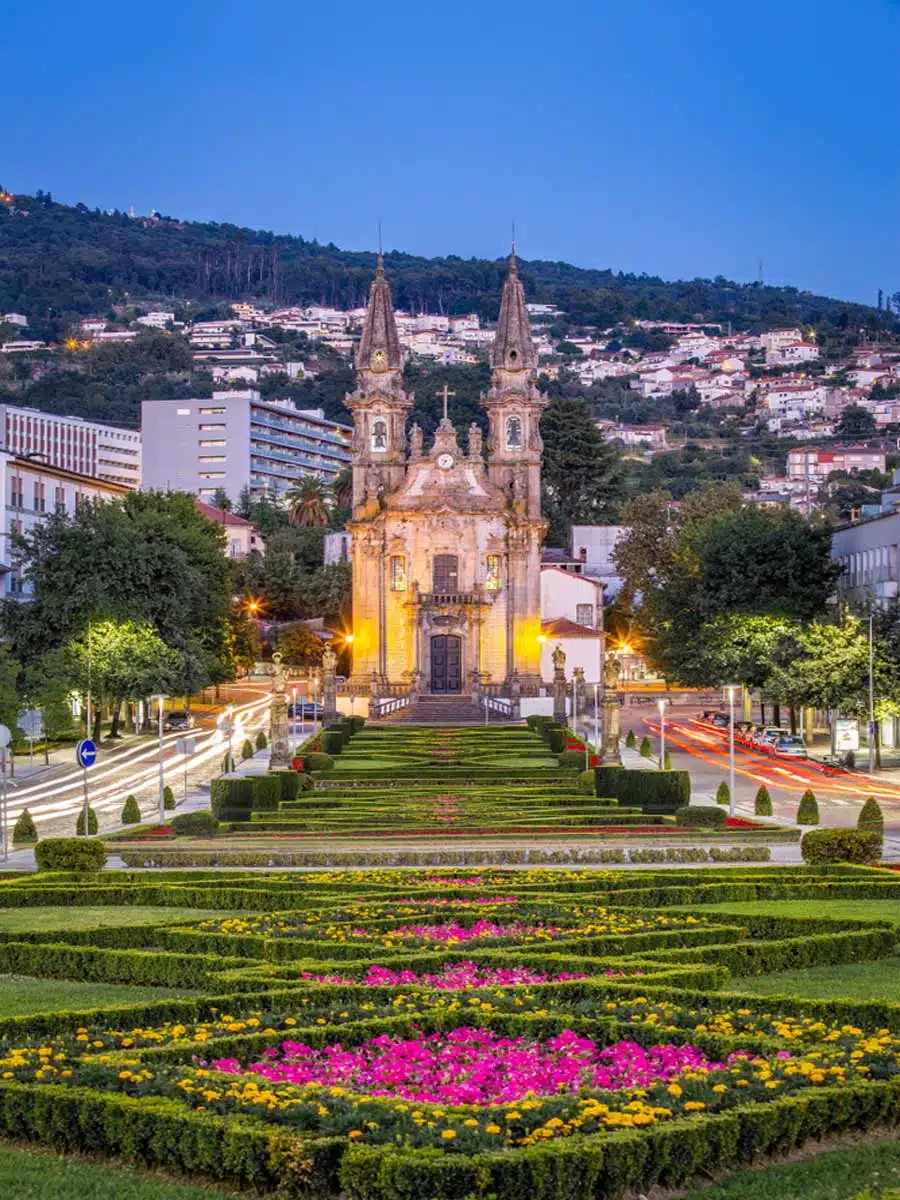
This charming medieval town is the birthplace of Portugal, so you really shouldn’t miss out on this heritage-rich site.
There are artisan shops to browse and the two main squares, Largo da Oliveira and Santiago, where cheerful cafés will warm you up with coffee or wine.
Visit the 10th-century Guimarães Castle where Afonso Henriques, the first king of Portugal, was born, or take a cable car up to Monte da Penha. The views are splendid.
How to Get There: Take the train from Campanha Station.
Average journey duration: 57 minutes.
Hassle-free option: Book this full-day tour with lunch.
Fátima
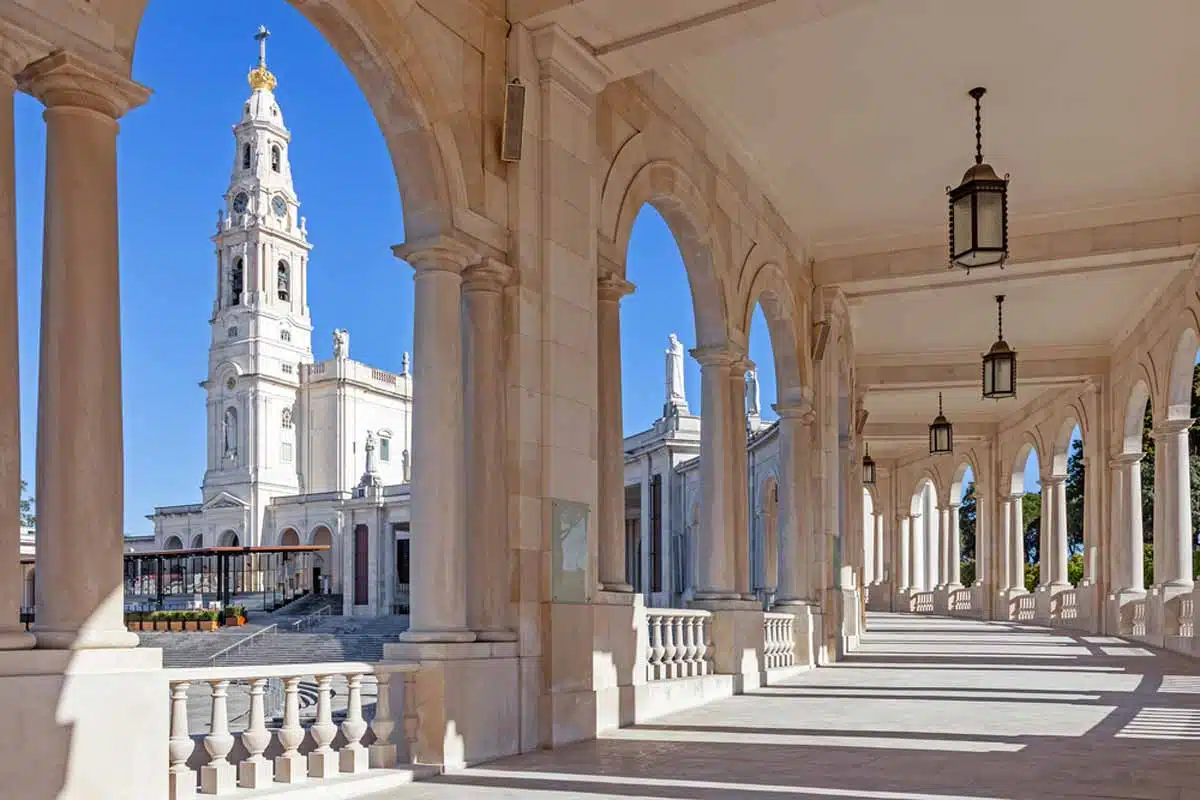
It’s a slower-paced city, but it’s also a great Catholic pilgrimage site in Europe. Three shepherd children saw a vision of Mother Mary in 1917, and since then believers flock here seeking blessings.
Head to the Basilica de Nossa Senhora de Rosario to pay your respects at the graves of two of the shepherd kids. Take your time exploring the rest of the Sanctuary of Fátima — it’s pretty huge.
How to Get There: You can take the train from Porto Sao Bento station to Fátima.
Average journey duration: 2 hours 25 minutes to 3 hours 30 minutes.
Hassle-free option: Book this full day tour.
Coimbra
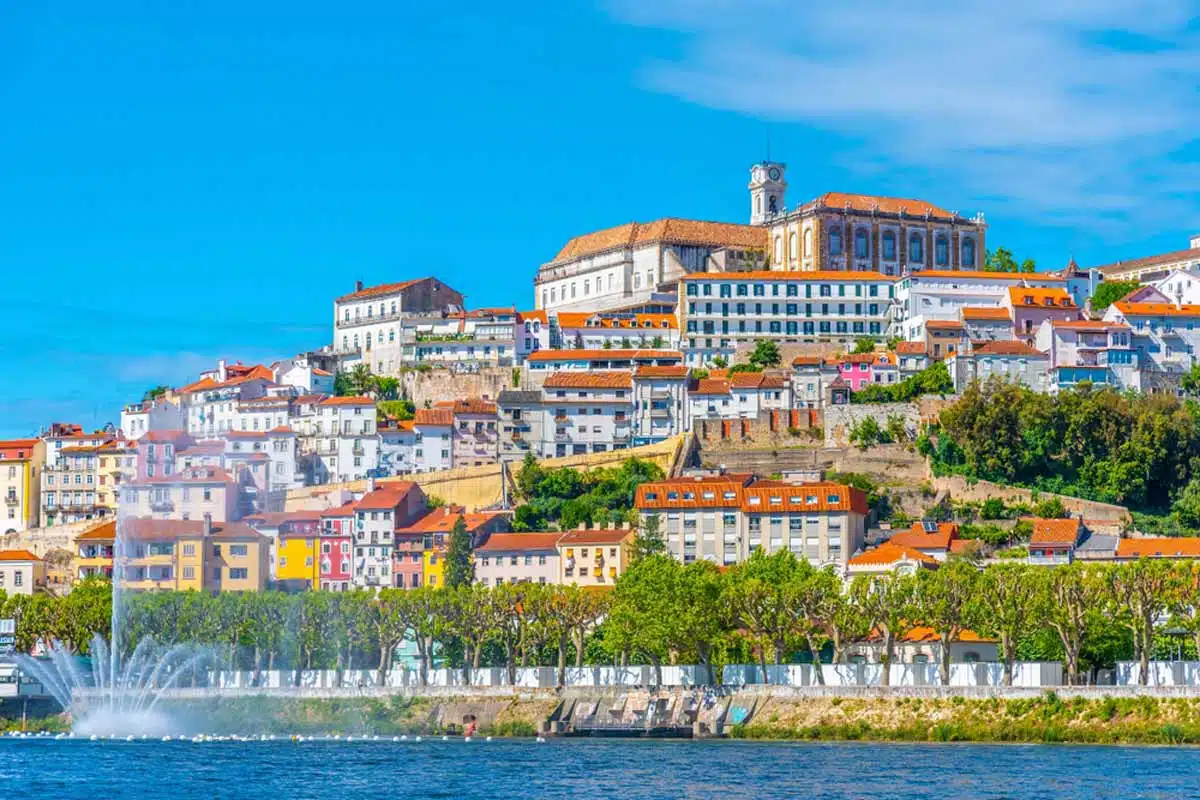
There’s plenty to see, but luckily Coimbra is quite compact so you can walk between attractions.
The Old Town area is a must, as is the University of Coimbra and the gorgeous Joanina Library (even if you’re not into books). The Botanical Garden is perfect for some tranquility and oneness with nature, followed by a leisurely stroll along the picturesque riverfront.
How to Get There: The train from Campanha Station.
Average journey duration: 1 hour and 20 minutes.
Hassle-free option: Book this private day trip.
Viana Do Castelo
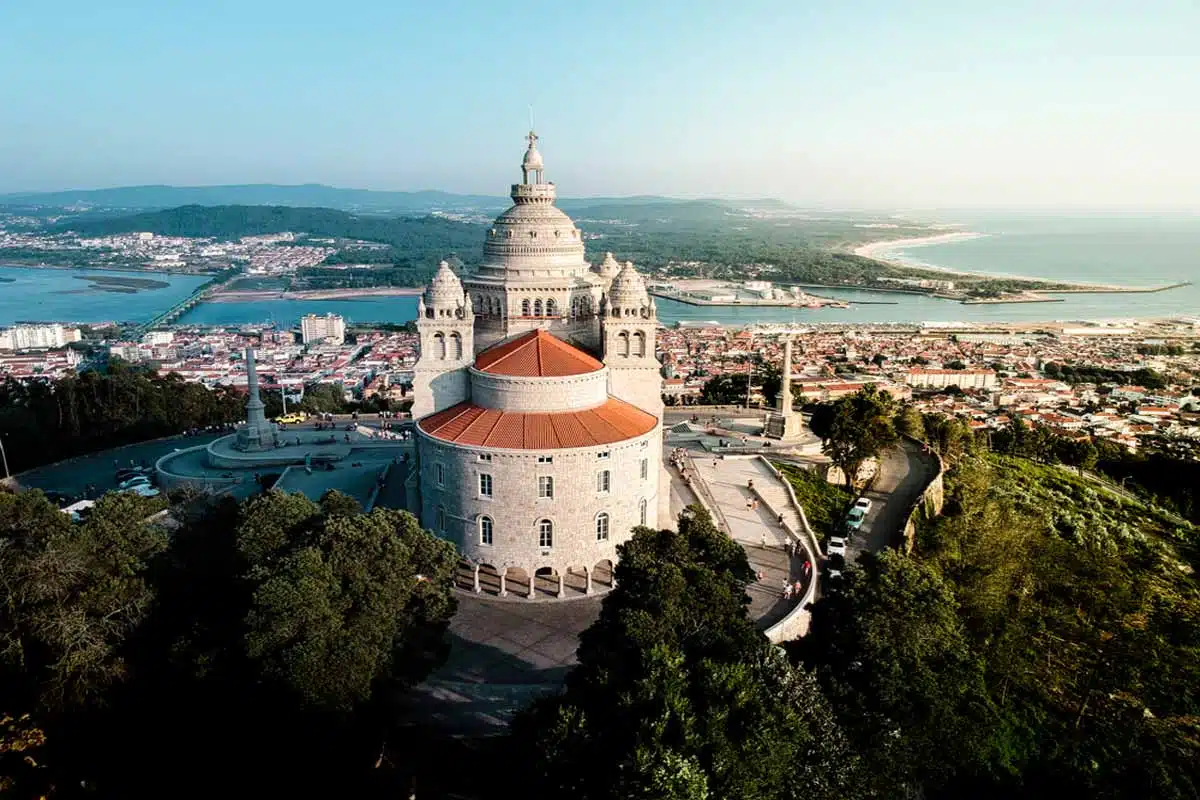
It’s not well-known, which means fewer tourists to contend with. But this city has much to offer. I’ll start with the Praça da Republica square, surrounded by cafés and shops amongst architectural treasures.
You can also make your way to the Santuario de Santa Luzia landmark via an incline railway. Water activities like kayaking tours are also popular here.
Make sure to try the Pescada a Vianense and the Caldo Verde — a delicacy fish dish and a kale and potato soup — while you’re there. Simply delicious.
How to Get There: Take a train ride from Campanha Station.
Average journey duration: 1 hour and 40 minutes.
Amarante
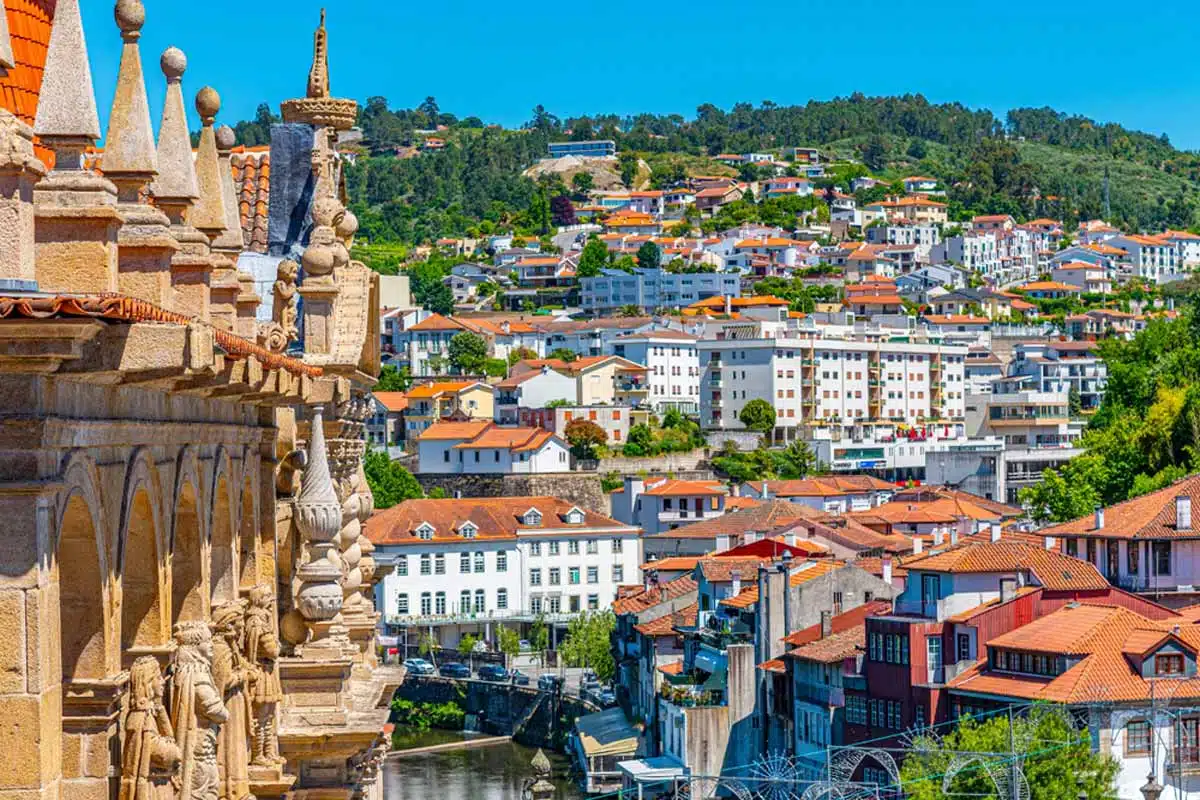
Art and architecture dominate this small city, as do certain giggle-worthy sweet treats sold by elderly ladies in stalls. The cakes have a rather naughty shape as a symbol of fertility, so do the touristy thing and buy one from the old gals for the fun of it.
Then head to the church and monastery of São Gonçalo and increase your chances of finding love by rubbing the statue above his tomb. Explore the on-site art museum afterwards.
How to Get There: Take the Rede Expressos bus from Porto to Amarante.
Average journey duration: 35 minutes to 50 minutes.
Peneda-Gerês National Park
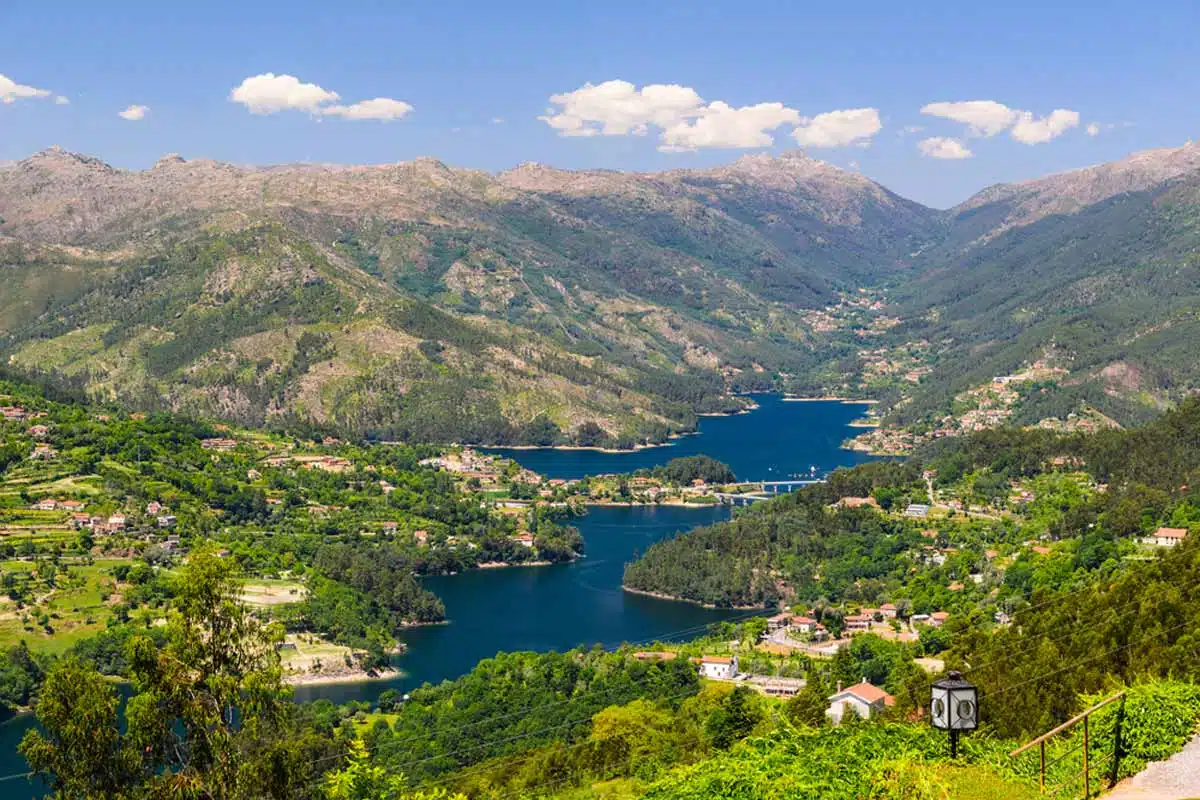
Roaring waterfalls, wild horses, and rolling landscapes for miles — oh, my nature-loving heart!
Bask in the vistas from the Vale da Peneda viewpoint, or go for a swim in the Portela do Homem waterfall.
For a food break, visit one of the quaint nearby towns like Soaja, or Termas do Gerês where they have thermal waters to cure what ails you.
How to Get There: Take the Rede Expressos bus from Porto to Braga, then Braga to Gerês.
Average journey duration: 3 hours.
Hassle-free option: Book this 4X4 tour.
Matashinos
It’s the closest beach to Porto, and is it’s own city famous for incredible seafood with over 200 restaurants clammering to satisfy your hunger.
You can also visit the Castelo do Queijo (Cheese Castle), which is — disappointingly — cheese-less.
If modern art is more your thing, check out the impressive Rotunda da Anémona by Janet Echelman and finish your day with a stroll along the beach.
How to Get There: Take the Line 500 bus from Porto.
Average journey duration: 20 minutes.
Capela Do Senhor Da Pedra
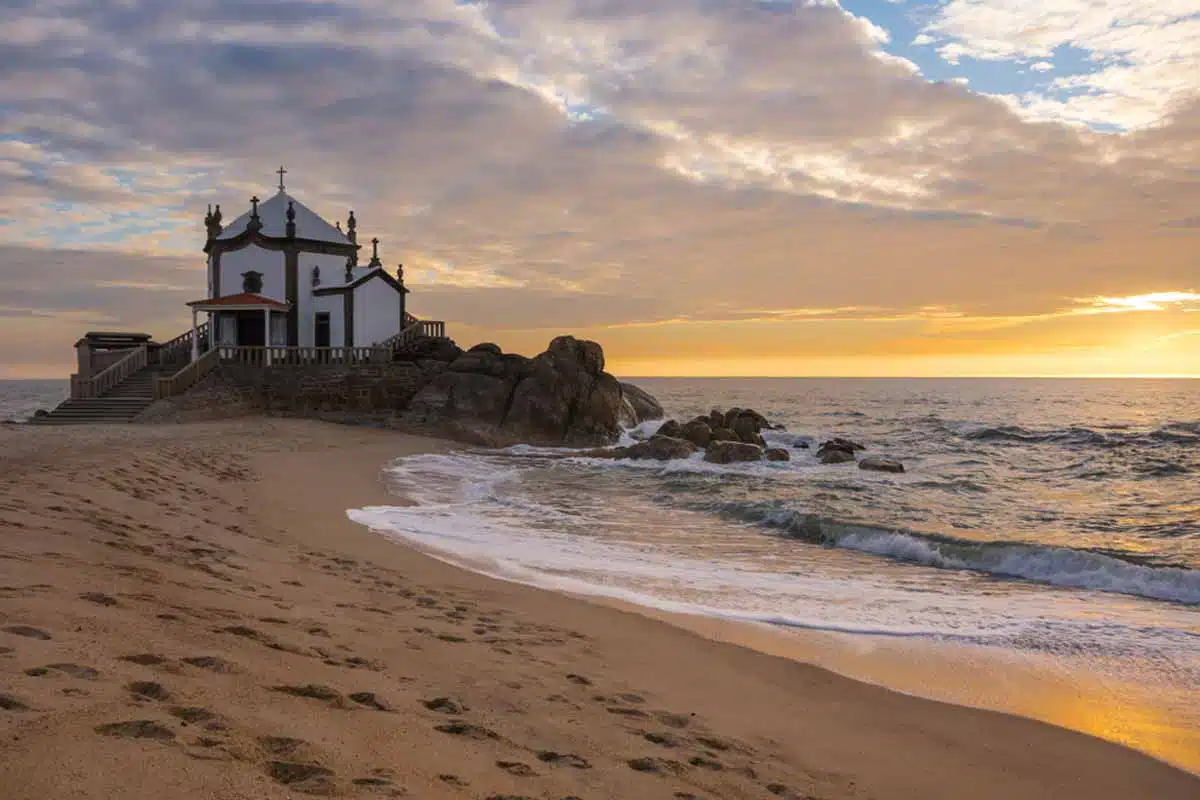
It’s famous for the Capela Do Senhor de Pedra, a chapel on the beach. It was once a pagan worship site transformed when Christianity overtook Europe, but still makes for a unique attraction.
You can spend the day on the beach afterwards if you want, or visit the colourful fishing villages nearby.
How to Get There: Take the train to Miramar.
Average journey duration: 30 minutes.
Vila Do Conde
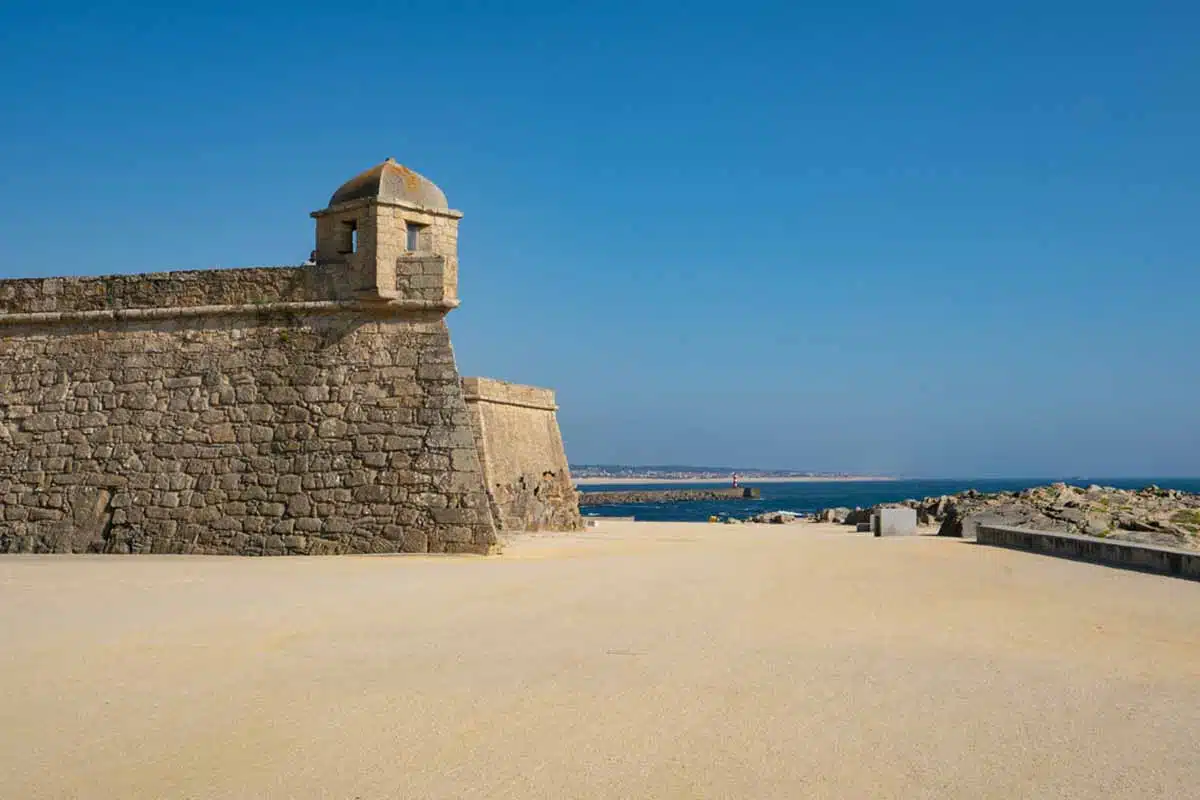
The Saint Claire Monastery dominates the skyline of this small fishing village with a delightful historic centre and wonderful beaches.
There’s an ancient aqueduct to peruse, the Gothic Igreja da Matriz Church, and the Nau Quinhentista, a replica of a 16th-century Portuguese sailing ship. Otherwise simply laze away the day on the beach.
How to Get There: Take the bus from Gonçalo Cristovão Terminal to Vila do Conde.
Average journey duration: 55 minutes.
Vigo
This Spanish city is a must, with its magnificent estuary and industrial architecture. Settle down for some tapas in the Old Town, or relax on one of the city’s many beaches where water sports are superbly popular.
You can always take to the air for a fantastic aerial view of the city, or visit the Cies Islands — getting a tan and enjoying some Spanish sun is a win in my books.
How to Get There: Take the Autna bus from Porto.
Average journey duration: 1 hour and 20 minutes.
Practical Tips for Easy Day Trips From Porto
- Rent a car. It’s often faster than the train.
- Plan ahead what sights you want to see and account for travel time there and back.
- Make bookings in advance where possible for an easy experience.
- Wear comfortable shoes and clothes and make sure you bring plenty of water with you while travelling.
Day Trips from Porto: Map
Best Day Trips from Porto: Read Next
Love This? Save and Share on Pinterest
